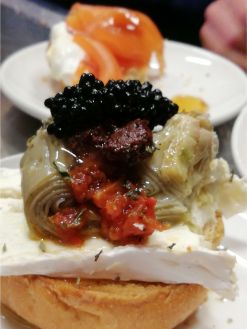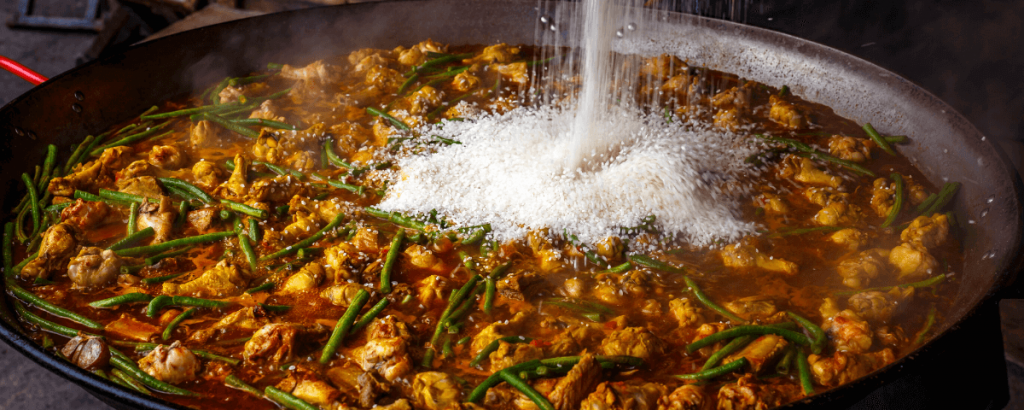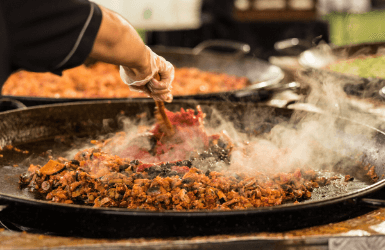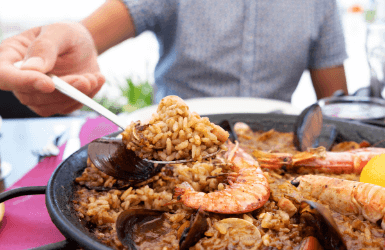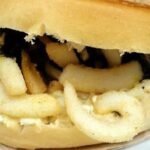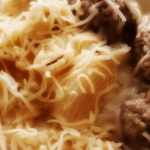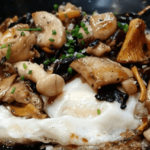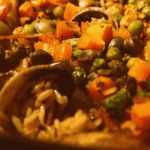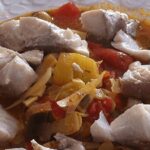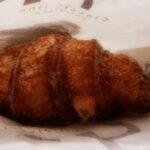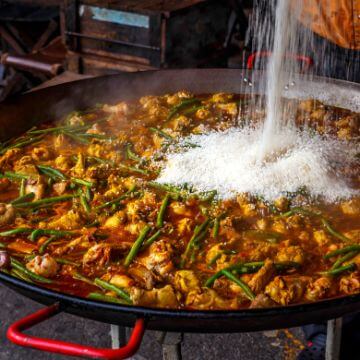
What Is Paella?
FACTS AND HISTORY OF PAELLA IN SPAIN
Paella is one of the most iconic dishes from Spain. Made of rice cooked in a shallow pan with two side handles, no tourist will leave Spain without ordering it. Spanish people also eat it regularly in all its different varieties: the most famous is the seafood version, but we’ll discuss some more below.
It can take several hours to prepare Spanish paella from scratch, but in a restaurant you’ll only be made to wait around 20 minutes. That’s because they they have the base of the dish ready, so you only need to wait for the rice to get cooked. Spaniards usually order a light starter (salad or some tapas) to munch while they wait.
Facts and history of paella you need to know about:
1
The paella origins:
Rice arrived to the Mediterranean coast of Spain in the 700’s with Alexander the Great, but it was not a popular ingredient for a while. Several centuries later, the Arabic domination of Al-Andalus improved the irrigation systems. They also brought in products that were “exotic” for the time, saffron being one of them.
Unfortunately, rice lost popularity during the Reconquest and the middle ages. It continued to be produced in the region of Valencia, though, where the recipe originated. And in the 1700’s the word paella is already used to refer to a particular recipe. From there, its popularity would only grow.
2
Paella meaning:
The word paella means pan in Valencian Catalan. In Spanish the pan used for paella is actually called “paellera”. The word could have multiple origins: the Latin term “patella” would be the most accepted. Another possibility would be the Arabic word “baqiya”, that means left overs – a reference to the humble ingredients of the dish. And since it was the Arabic who promoted rice in Spain in the early Middle Ages, this option can’t be discarded.
Finally, there’s a popular myth in Valencia that says that a man created the dish for the maiden he was in love with. So the dish was “for her”, “Pa ella”. Probably not the real origin of the dish, but it’s a cute story. And it’s true that paella is a dish mostly cooked by men in Spain.
3
Paella ingredients:
There are as many recipes of paella as there are people that can cook it. All paella types have in common some basic ingredients: round rice (like the bomba variety), tomato, water, olive oil, saffron and salt. But what comes as a surprise is that seafood is not an official ingredient of the classic paella.
According to the Government of Valencia, the authentic traditional Paella Valenciana incorporates chicken, rabbit, green beans and lima beans. Other accepted additional ingredients are garlic, artichoke, duck, paprika, rosemary and escargots.
Any paella not based on these, is not a true Valencian Paella. And purist often dismiss other paella versions as “rice with things”. But the reality is that outside the region of Valencia you’ll only find the “real” Valencia style paella in specialty restaurants.
4
Other types of paella
Paella marinera is the seafood paella any non-Valencian person thinks of when talking about paella. It lacks of veggies and meat, and incorporates squid, calamari, lobster or shrimp, clams and mussels. Paella mixta is another popular version, a mix of seafood with meat (often pork and chicken), plus onion and green peas.
Paella Parellada or Paella del Senyoret is a “cleaner” version of paella mixta where the seafood comes shelled. The origin may come from the early 1900’s when a dandy called Juli Mari Parellada asked his waiter to bring a paella that was easier to eat. Vegetarian paellas aren’t rare either. You might also be interested in other rice dishes from Spain.
5
When is paella eaten
Because making paella from scratch takes hours, Spaniards consider it a Sunday delicacy. In Valencia it is also eaten during special holidays. And you’ll often see massive paellas cooked in the street as part of local festivals. Also, many restaurants in Catalonia and Madrid also serve it on Thursday.
In Madrid mostly because fresh fish caught on Monday didn’t get that far inland until Thursday. In both cities because Thursday was the maids day off in the early 1900’s. The maids would leave all the ingredients ready beforehand, so the next day the lady of the house only needed to cook the rice and still have a fancy lunch. In any case, Spaniards prefer to eat paella for lunch because it’s a heavy dish that takes long to digest.
As you can see, paella has become an iconic recipe of Spain and a symbol of the region of Valencia. There’s even an emoticon for it! (that had to be redesigned a few times due to the complaints of some purists…). There are societies, contests and festivals devoted to it, and it should be a keystone of your next trip to Spain.
What paella type would you like to try?
Marta
MORE BARCELONA TIPS FOR YOU:
SHARE WITH YOUR TRAVEL MATES
RESEARCHING FOR A TRIP IS TIME-CONSUMING…
Need more inspiration?
Our 100% FREE Barcelona Collection will give you everything you need to organize the trip of your lifetime to Barcelona.
BEST INSIDER TIPS FROM THE PROS!
